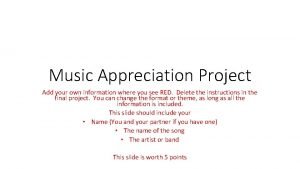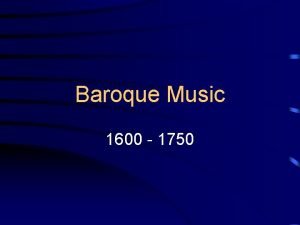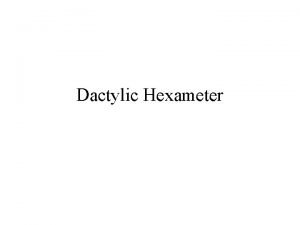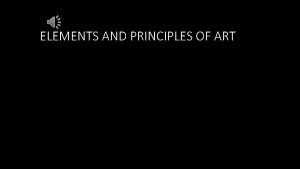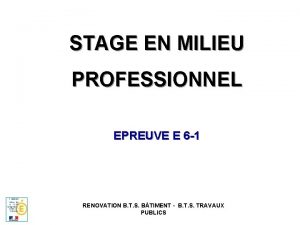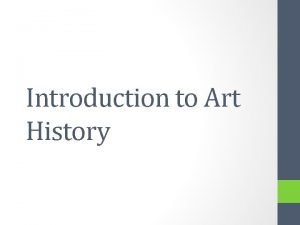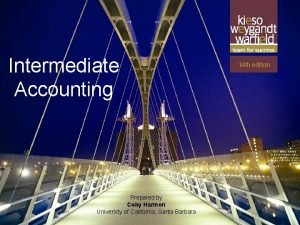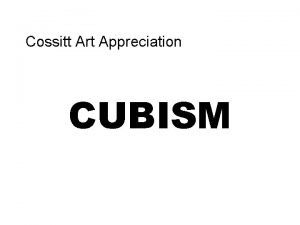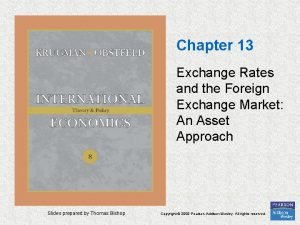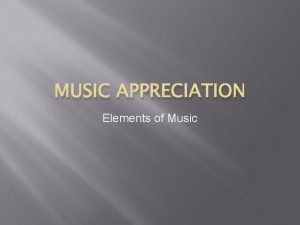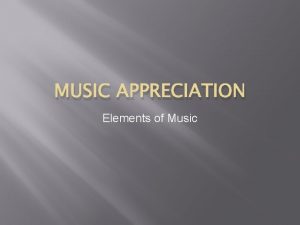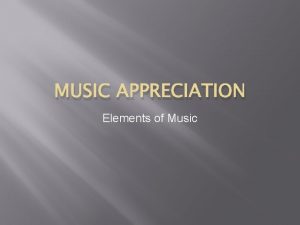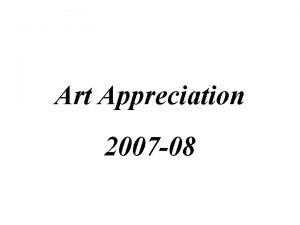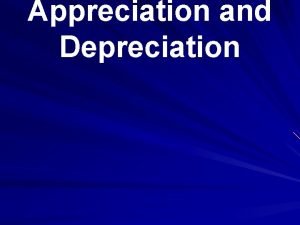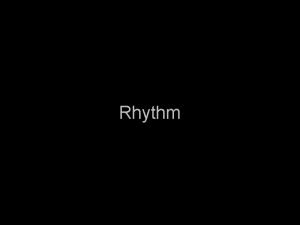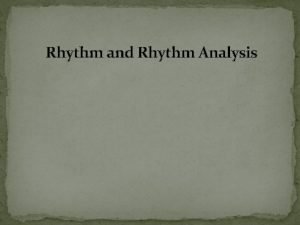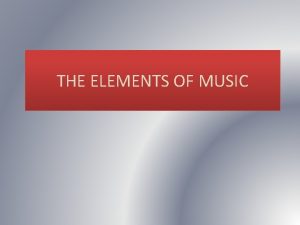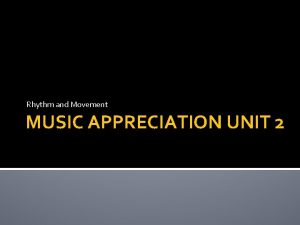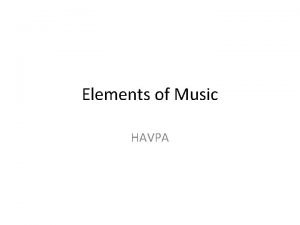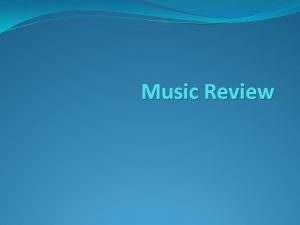MUSIC APPRECIATION Elements of Music Rhythm Element of
















- Slides: 16

MUSIC APPRECIATION Elements of Music

Rhythm – Element of TIME in music. Duration - How long a sound (or silence) lasts. Beat - The beat is the basic unit of time, the pulse. Tempo - The pace of the fundamental beat. Syncopation - An "off-the-beat" sound or accent.

Rhythm � Meter - Beats organized into recognizable/ recurring accent patterns. Meter can be seen/felt through the standard patterns used by conductors.

Music Example � � Snare Drum solo The Washington Post (1889) John Sousa � Waltz No. 2 – From Jazz Suite No. 2 Demitri Shostakovich � Billie Jean � Michael Jackson

Melody - The presentation of pitch. Many famous musical compositions have a memorable melody or theme. Pitch - The word used to describe the highness or lowness of a musical sound. Disjunct Motion – Music in stepwise motion Conjunct Motion – Music in non-stepwise (jumpy, skipping) motion

Music Example � Theme from Schindler’s List Composer: John Williams

Harmony - The VERTICALIZATION of pitch. Often, harmony is thought of as the art of combining pitches into chords (several notes played simultaneously as a "block"). Consonant - a smooth-sounding harmonic combination Dissonant - a harsh-sounding harmonic combination

Music Example � � Twinkle Little Star Dissonant Music

Dynamics All musical aspects relating to the relative loudness (or quietness) of music fall under the general element of DYNAMICS.

Tone Color (or TIMBRE -pronounced "TAM-BER") � If you play a "C" on the piano and then sing that "C", you and the piano have obviously produced the same pitch; however, your voice has a different sound quality than the piano. � Composers use timbre much like painters use colors to evoke certain effects on a canvas.

Texture - Refers to the number of individual musical lines (melodies) and the relationship these lines have to one another. Monophonic Texture – Music with only one note sounding at a time (having no harmony accompaniment). or

Texture Homophonic Texture - Music with two or more notes sounding at a the same time, but generally featuring a prominent melody in the upper part, supported by a less intricate harmonic accompaniment underneath.

Texture � Polyphonic Texture - Music with two or more independent melodies sounding at the same time.

Music Example � Little Fugue in G minor (1703 -1705) � Johann Sebastian Bach

Form - The overall structure or plan of a piece of music. Basic Forms Strophic Form: a design in VOCAL music, in which the same music is used for several different verses (strophes) of words. [Example: "Deck the Halls" has many verses of words sung to the same music. ] Verse 1. . . Verse 2. . . Verse 3 (etc. ) Through-composed: a structure in which there is no repeat or return of any large-scale musical section. ABCDE. . .

Form Binary Form: a two-part form in which both main sections are repeated (as indicated in the diagram by "repeat marks"). The basic premise of this form is CONTRAST: Ternary Form a three-part form featuring a return of the initial music after a contrasting section. Symmetry and balance are achieved through this return of material. ABA
 Beats organized into recognizable/recurring accent patterns
Beats organized into recognizable/recurring accent patterns Music appreciation project
Music appreciation project Online music portfolio
Online music portfolio Baroque music 1600 to 1750
Baroque music 1600 to 1750 Dactylic meter
Dactylic meter Rhythm and balance in art
Rhythm and balance in art Distinguish between a signal element and a data element.
Distinguish between a signal element and a data element. Signal element vs data element
Signal element vs data element Exemple appréciation de stage par le tuteur
Exemple appréciation de stage par le tuteur Introduction of art appreciation
Introduction of art appreciation Share appreciation rights
Share appreciation rights Esop valuation for unlisted companies
Esop valuation for unlisted companies Appreciation for diversity
Appreciation for diversity What is cubism in art appreciation
What is cubism in art appreciation Appreciation and depreciation of currency
Appreciation and depreciation of currency Peason
Peason Appreciation of the currency
Appreciation of the currency

